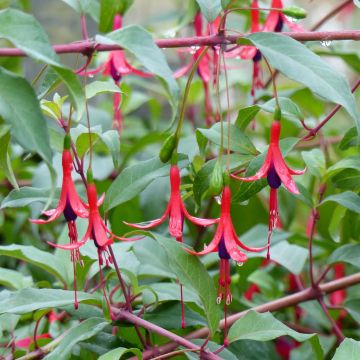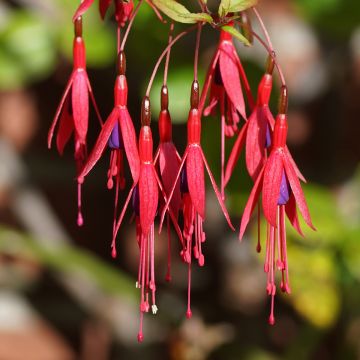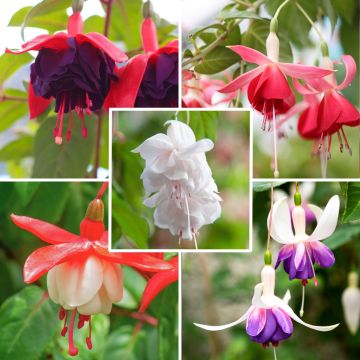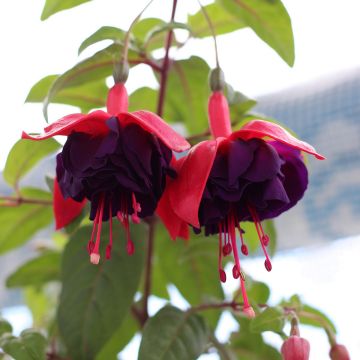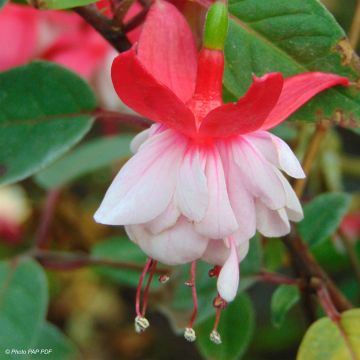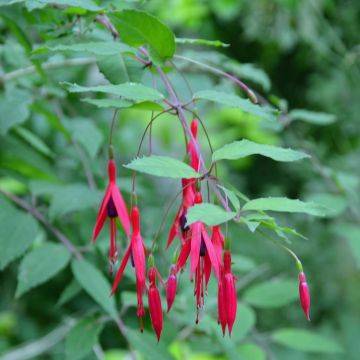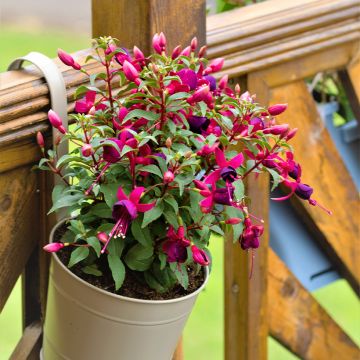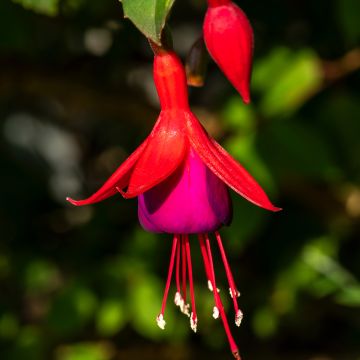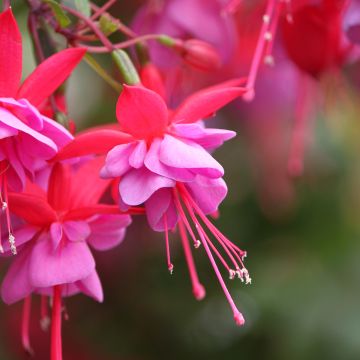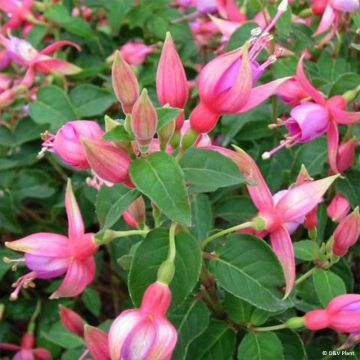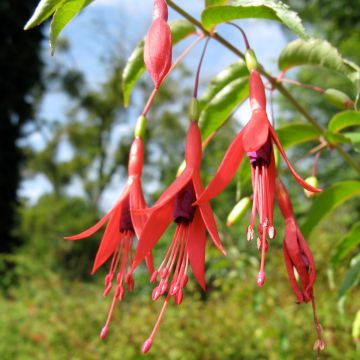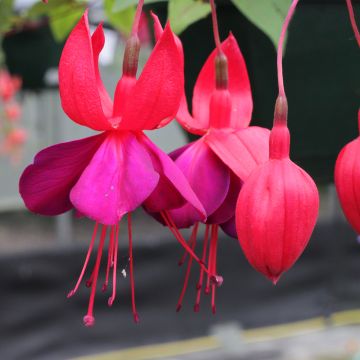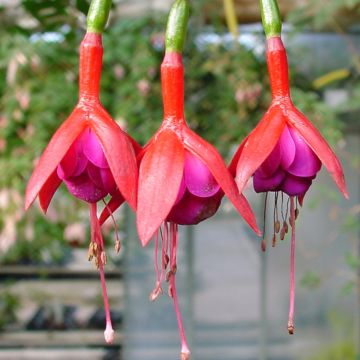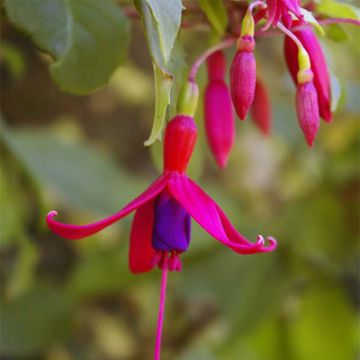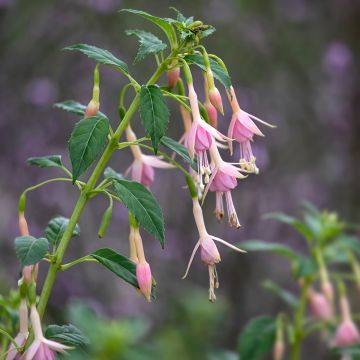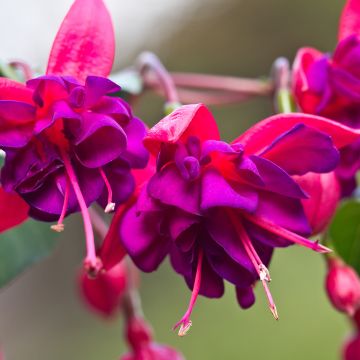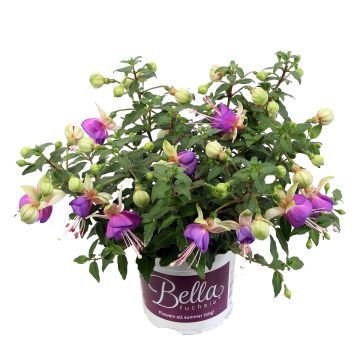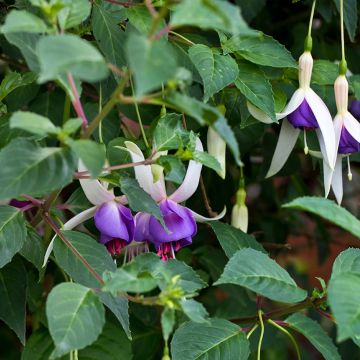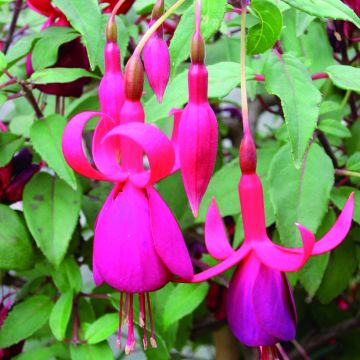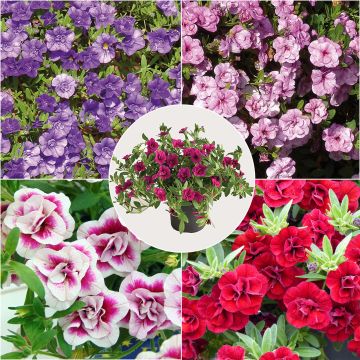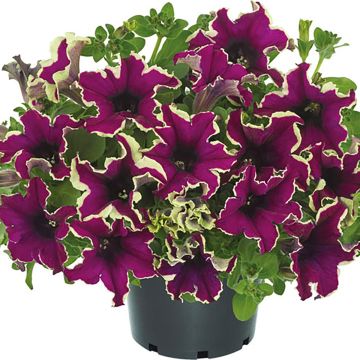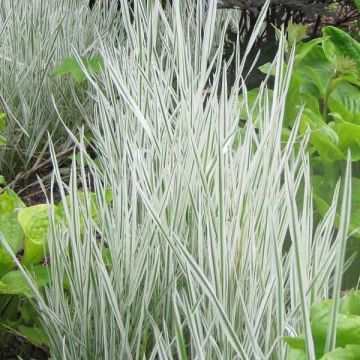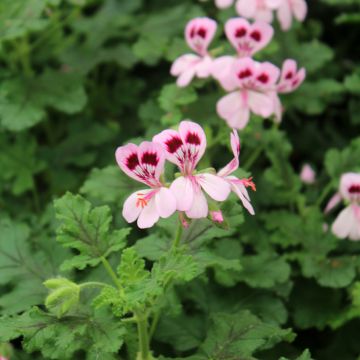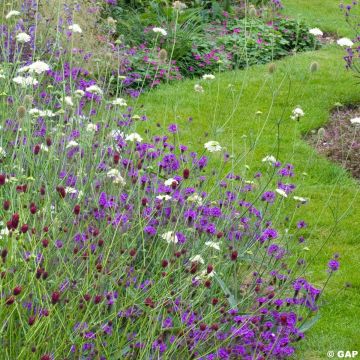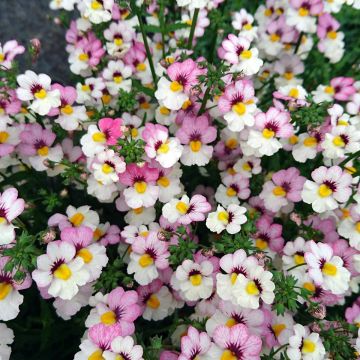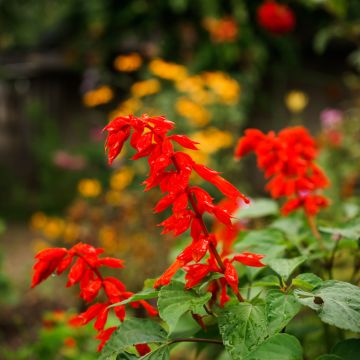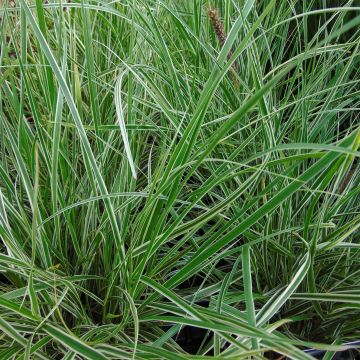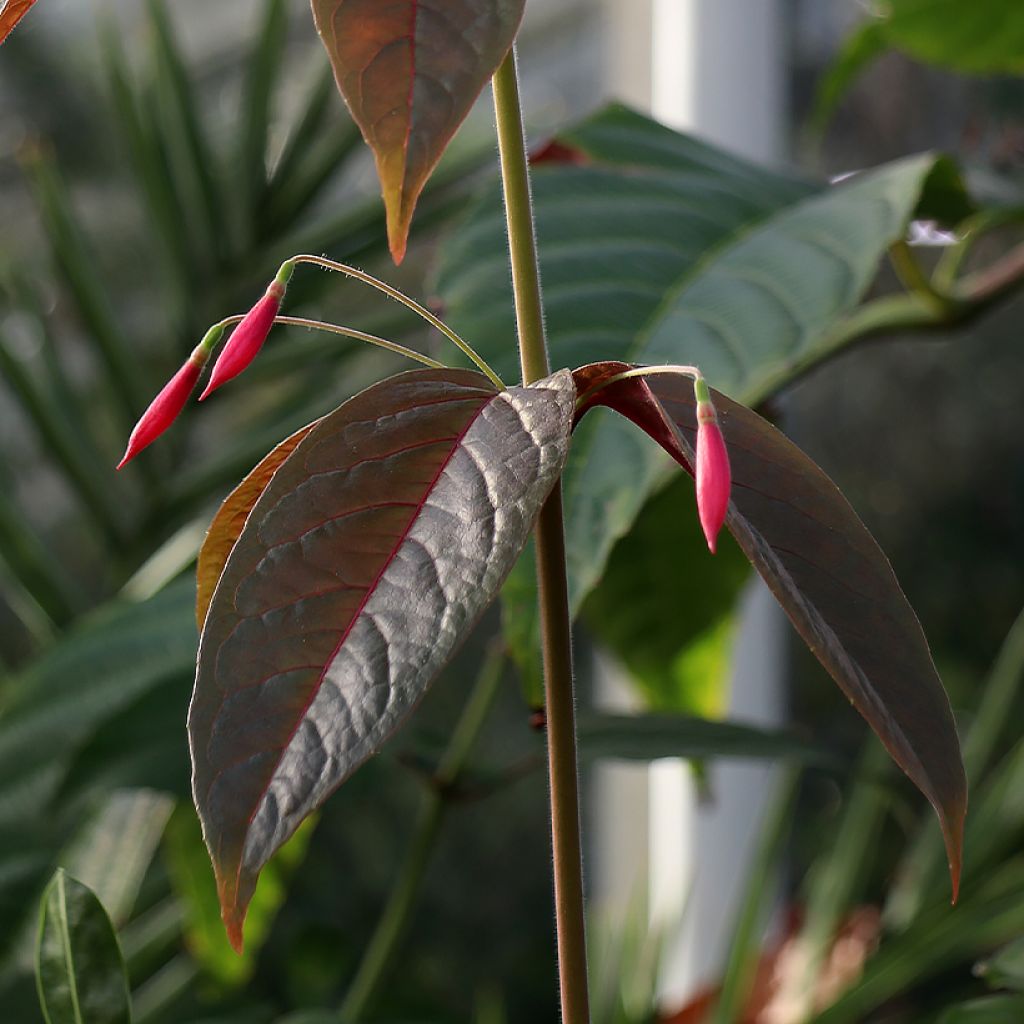

Fuchsia alpestris Grimpant
Fuchsia alpestris Grimpant
Fuchsia alpestris Grimpant
Why not try an alternative variety in stock?
View all →This plant carries a 24 months recovery warranty
More information
We guarantee the quality of our plants for a full growing cycle, and will replace at our expense any plant that fails to recover under normal climatic and planting conditions.
From €5.90 for pickup delivery and €6.90 for home delivery
Express home delivery from €8.90.
Does this plant fit my garden?
Set up your Plantfit profile →
Description
Fuchsia alpestris 'Grimpant' has, as its cultivar name suggests, a desire to climb trees, fences, or walls, reaching up to about 2m. It is distinguished by wide semi-evergreen leaves that turn red in autumn, and slender typical, red flowers with incurved sepals and long stamens. It is relatively hardy, classified in USDA zone 8, which is around -8 to -10°C, it regrows from the crown in spring in case of a cold winter and prefers light shade and cool, well-drained soil.
Fuchsia alpestris is a botanical species native to Brazil, belonging to the onagraceae family. In its natural habitat, it is found in thickets and low forests near granite outcrops at altitudes of 1,400 to 1,600 metres. Sometimes considered a climbing plant due to its remarkable vigour, this upright shrub only needs good conditions to expand. It can reach a height of 3m or more if winter does not cut back its vegetation, if the atmosphere remains humid and temperate, and the soil is fertile but well-drained. In cultivation, in our cooler climates, it generally reaches a height of 1 to 2m and a width of 1m. Its young branches develop rapidly in spring, bearing oval and elliptical leaves, rather wide for a fuchsia, along their entire length. They are shiny, medium to dark green, and provide a beautiful background for the flowers. These numerous, small flowers bloom from August to November in the axils of the leaves, hanging at the end of slender stems, swaying in the wind. They consist of a long fleshy calyx with four thick, pointed, red fuchsia-coloured sepals that curve towards the sky when they open. This 'underskirt' tops a corolla of violet petals from which long red stamens emerge. This self-fertile species produces small black fruits with purplish highlights that can be eaten, although the quality of their flavour depends greatly on the growing conditions.
Fuchsia alpestris 'Grimpant' offers fairly good cold resistance, making it suitable for cultivation in open ground in most regions, with adequate protection during the coldest periods. To make it climb, its long branches can be tied against a wall or pergola. However, it will need to be trained or provided with support, as it does not have organs to cling with, like climbing roses. The delicate, fine flowers of this variety should not be overwhelmed by excessive blooming that could hide their beauty. Fuchsia alpestris 'Grimpant' pairs well with plants with decorative foliage in partial shade, and moist soil, such as blue hostas or ferns, shade-loving hydrangeas with flat flowers, bugbanes, or rodgersias. It is ideally placed in the background or in front of an evergreen hedge, depending on the size of the garden.
Report an error about the product description
Plant habit
Flowering
Foliage
Botanical data
Fuchsia
alpestris
Grimpant
Onagraceae
South America
Other Fuchsia
Planting and care
This Fuchsia settles in shade or partial shade in moist, fertile, slightly acidic, light and well-drained soil, retaining moisture in summer. It does not appreciate scorching sun or waterlogged soils in winter. Morning sun is well tolerated. You can add some gravel to the bottom of the hole when planting.
Its leaves are deciduous as soon as the temperature reaches -5°C and its stems sag below -10°C. However, if your climate is harsher and the frosts are intense (-15°C), the stems will die back, which will not kill your Fuchsia. You can prune them and protect the crown by mulching or mounding it. The stems will sprout again in spring. You can prune the stems again if necessary at the beginning of spring by removing the dead parts. An annual pruning after flowering stimulates growth and promotes flowering the following year.
Planting period
Intended location
Care
This item has not been reviewed yet - be the first to leave a review about it.
Plug plants - Annuals
Haven't found what you were looking for?
Hardiness is the lowest winter temperature a plant can endure without suffering serious damage or even dying. However, hardiness is affected by location (a sheltered area, such as a patio), protection (winter cover) and soil type (hardiness is improved by well-drained soil).

Photo Sharing Terms & Conditions
In order to encourage gardeners to interact and share their experiences, Promesse de fleurs offers various media enabling content to be uploaded onto its Site - in particular via the ‘Photo sharing’ module.
The User agrees to refrain from:
- Posting any content that is illegal, prejudicial, insulting, racist, inciteful to hatred, revisionist, contrary to public decency, that infringes on privacy or on the privacy rights of third parties, in particular the publicity rights of persons and goods, intellectual property rights, or the right to privacy.
- Submitting content on behalf of a third party;
- Impersonate the identity of a third party and/or publish any personal information about a third party;
In general, the User undertakes to refrain from any unethical behaviour.
All Content (in particular text, comments, files, images, photos, videos, creative works, etc.), which may be subject to property or intellectual property rights, image or other private rights, shall remain the property of the User, subject to the limited rights granted by the terms of the licence granted by Promesse de fleurs as stated below. Users are at liberty to publish or not to publish such Content on the Site, notably via the ‘Photo Sharing’ facility, and accept that this Content shall be made public and freely accessible, notably on the Internet.
Users further acknowledge, undertake to have ,and guarantee that they hold all necessary rights and permissions to publish such material on the Site, in particular with regard to the legislation in force pertaining to any privacy, property, intellectual property, image, or contractual rights, or rights of any other nature. By publishing such Content on the Site, Users acknowledge accepting full liability as publishers of the Content within the meaning of the law, and grant Promesse de fleurs, free of charge, an inclusive, worldwide licence for the said Content for the entire duration of its publication, including all reproduction, representation, up/downloading, displaying, performing, transmission, and storage rights.
Users also grant permission for their name to be linked to the Content and accept that this link may not always be made available.
By engaging in posting material, Users consent to their Content becoming automatically accessible on the Internet, in particular on other sites and/or blogs and/or web pages of the Promesse de fleurs site, including in particular social pages and the Promesse de fleurs catalogue.
Users may secure the removal of entrusted content free of charge by issuing a simple request via our contact form.
The flowering period indicated on our website applies to countries and regions located in USDA zone 8 (France, the United Kingdom, Ireland, the Netherlands, etc.)
It will vary according to where you live:
- In zones 9 to 10 (Italy, Spain, Greece, etc.), flowering will occur about 2 to 4 weeks earlier.
- In zones 6 to 7 (Germany, Poland, Slovenia, and lower mountainous regions), flowering will be delayed by 2 to 3 weeks.
- In zone 5 (Central Europe, Scandinavia), blooming will be delayed by 3 to 5 weeks.
In temperate climates, pruning of spring-flowering shrubs (forsythia, spireas, etc.) should be done just after flowering.
Pruning of summer-flowering shrubs (Indian Lilac, Perovskia, etc.) can be done in winter or spring.
In cold regions as well as with frost-sensitive plants, avoid pruning too early when severe frosts may still occur.
The planting period indicated on our website applies to countries and regions located in USDA zone 8 (France, United Kingdom, Ireland, Netherlands).
It will vary according to where you live:
- In Mediterranean zones (Marseille, Madrid, Milan, etc.), autumn and winter are the best planting periods.
- In continental zones (Strasbourg, Munich, Vienna, etc.), delay planting by 2 to 3 weeks in spring and bring it forward by 2 to 4 weeks in autumn.
- In mountainous regions (the Alps, Pyrenees, Carpathians, etc.), it is best to plant in late spring (May-June) or late summer (August-September).
The harvesting period indicated on our website applies to countries and regions in USDA zone 8 (France, England, Ireland, the Netherlands).
In colder areas (Scandinavia, Poland, Austria...) fruit and vegetable harvests are likely to be delayed by 3-4 weeks.
In warmer areas (Italy, Spain, Greece, etc.), harvesting will probably take place earlier, depending on weather conditions.
The sowing periods indicated on our website apply to countries and regions within USDA Zone 8 (France, UK, Ireland, Netherlands).
In colder areas (Scandinavia, Poland, Austria...), delay any outdoor sowing by 3-4 weeks, or sow under glass.
In warmer climes (Italy, Spain, Greece, etc.), bring outdoor sowing forward by a few weeks.

































